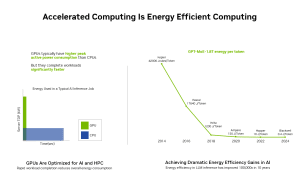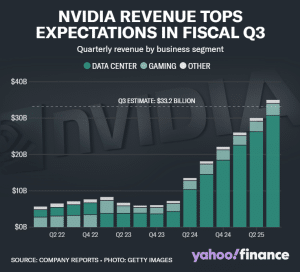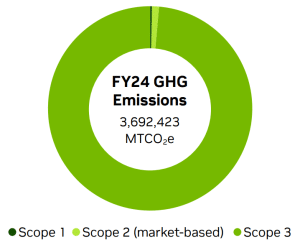Nvidia’s Q3 Earnings Surge Amid Booming AI Demand
Nvidia, the world’s largest publicly traded company by market cap, reported exceptional third-quarter results, driven by robust demand for its AI-focused chips. For the quarter ending October 27, revenue soared to $35 billion, a 94% increase from $18 billion last year. It also beats analyst’s estimates of $33.2 billion as shown below.
- The chipmaker’s net income more than doubled to $19 billion, compared to $9 billion in Q3 2023. Adjusted earnings per share stood at 81 cents, surpassing Wall Street’s expectations of 75 cents per share.
Nvidia’s data center revenue reached $30.8 billion, marking a 112% year-over-year growth. This was fueled by the Hopper platform’s popularity for AI applications, including large language models and generative AI tools. With gaming revenue also rising 15% to $3.3 billion, Nvidia continues to solidify its dominance across multiple sectors, driving the future of AI innovation.
CEO Jensen Huang highlighted the company’s pivotal role in AI adoption, stating:
“The age of AI is in full steam, propelling a global shift to Nvidia computing.”
Looking ahead, Nvidia anticipates Q4 revenue of $37.5 billion, slightly above analysts’ estimates of $37.09 billion. The company also provided updates on its next-gen Blackwell AI chips, set for production shipments in 2025. However, supply constraints are expected to persist through 2026, according to Chief Financial Officer Colette Kress.
Nvidia’s stock, which has surged 195% year-to-date, dipped 1% in after-hours trading despite its strong quarterly performance. Analysts remain optimistic though, emphasizing Nvidia’s leadership in AI.
Wedbush analyst Dan Ives described the results as a testament to the ongoing “AI Revolution,” projecting the company’s market cap to hit $4 trillion by 2025.
Emerging as a global tech leader, Nvidia captivated investors with its market growth and revolutionary advancements in AI and computing.
However, as the chipmaker reaches record-breaking valuations, the spotlight on its environmental practices and sustainability commitments has intensified. The company faces increasing scrutiny over its efforts to address climate change and reduce its substantial energy footprint.
Behind the Chips: The Carbon Cost of AI
AI and chip manufacturing are energy-intensive processes that contribute to greenhouse gas emissions throughout the supply chain. From mining rare metals to the high-temperature ovens required during chip fabrication, the production of advanced semiconductors is resource-heavy.
According to researchers, information and communications technologies—including data centers—are responsible for 1.8% to 2.8% of global GHG emissions. This figure is projected to rise significantly as AI adoption accelerates.
The International Energy Agency (IEA) estimates that the sector’s electricity consumption could double by 2026, potentially consuming 4% of global electricity—an amount comparable to Japan’s entire energy usage.
Nvidia’s Sustainability Initiatives
In response to these challenges, Nvidia has outlined a series of sustainability goals in its 2024 Corporate Responsibility Report. The company is committed to achieving 100% renewable electricity for all its offices and data centers by fiscal year 2025. This ambitious target reflects Nvidia’s dedication to reducing Scope 1 and Scope 2 emissions, which cover its direct operational carbon footprint.
Total FY2024 GHG emissions is 3,692,423 MTCO2e, with the following breakdown per source:
For Scope 3 emissions, which comprise most of the company’s GHG footprint and include those generated by its supply chain, Nvidia is working with suppliers to adopt science-based emission reduction targets. By 2026, Nvidia aims to engage suppliers responsible for at least 67% of its Scope 3 Category 1 emissions, encouraging them to align with the company’s climate standards.
While Nvidia has made significant strides, its lack of a comprehensive net zero strategy has drawn criticism. The company’s report highlights its greenhouse gas emissions and energy use—73,017 metric tons of CO2 equivalent and 496,901 megawatt hours, respectively, in 2023—but provides limited detail on how it plans to reach net zero.
Innovations Powering Nvidia’s Green Goals
Nvidia’s innovations, such as the Blackwell GPUs and its Earth-2 platform, are pivotal in reducing the environmental impact of AI and computing. The Blackwell GPUs consume up to 20 times less energy than traditional CPUs for complex workloads, while the Earth-2 platform offers advanced climate modeling capabilities, using 3,000 times less energy than conventional systems.
Liquid cooling is another area where Nvidia is making strides. Direct-to-chip liquid cooling technology significantly enhances data center efficiency, reducing water consumption and energy demand. This system aligns with Nvidia’s broader strategy to improve the sustainability of its operations and products.
Additionally, Nvidia’s Omniverse platform enables businesses to create digital twins—virtual replicas of physical operations. This innovation helps industries optimize energy use, reduce waste, and cut carbon emissions. For example, Wistron, a manufacturing company, used Nvidia’s Omniverse to save 120,000 kilowatt-hours of electricity annually and reduce CO2 emissions by 60,000 kilograms.
Green AI: A Sustainable Path Forward
The rise of AI has brought immense opportunities but also increased energy demands. Deloitte’s report on AI’s environmental footprint predicts that global data center power demand could reach 1,000 terawatt-hours (TWh) by 2030 and potentially 2,000 TWh by 2050.
Nevertheless, AI can significantly contribute to climate-neutral economies, as outlined in Deloitte’s study on Green AI. This concept focuses on minimizing AI’s environmental footprint by adopting renewable energy and optimizing hardware design.
Industry leaders have spearheaded Green AI efforts, particularly in accelerated computing. This approach relies on specialized hardware like GPUs, enabling faster, energy-efficient processing compared to CPUs, which handle tasks sequentially.

Notably, Nvidia is among the tech companies exploring nuclear energy as a sustainable solution to meet the growing energy needs of AI and data centers. Nuclear power provides a reliable, compact, and low-carbon energy source that can sustain the rapid expansion of AI technologies while mitigating their environmental impact.
The Path Ahead
The current COP29 discussions highlighted the need to power AI infrastructure with renewable energy and establish ethical guidelines for its use. By prioritizing environmental innovation, industries can leverage AI to foster a more sustainable and climate-conscious future.
Nvidia has demonstrated a commitment to energy-efficient innovations and renewable energy adoption, but a clear roadmap to net zero is highly significant.
By integrating sustainability deeper into its business strategy, Nvidia has the potential to lead not only in technology but also in climate action, setting a benchmark for the industry and ensuring its long-term success.





